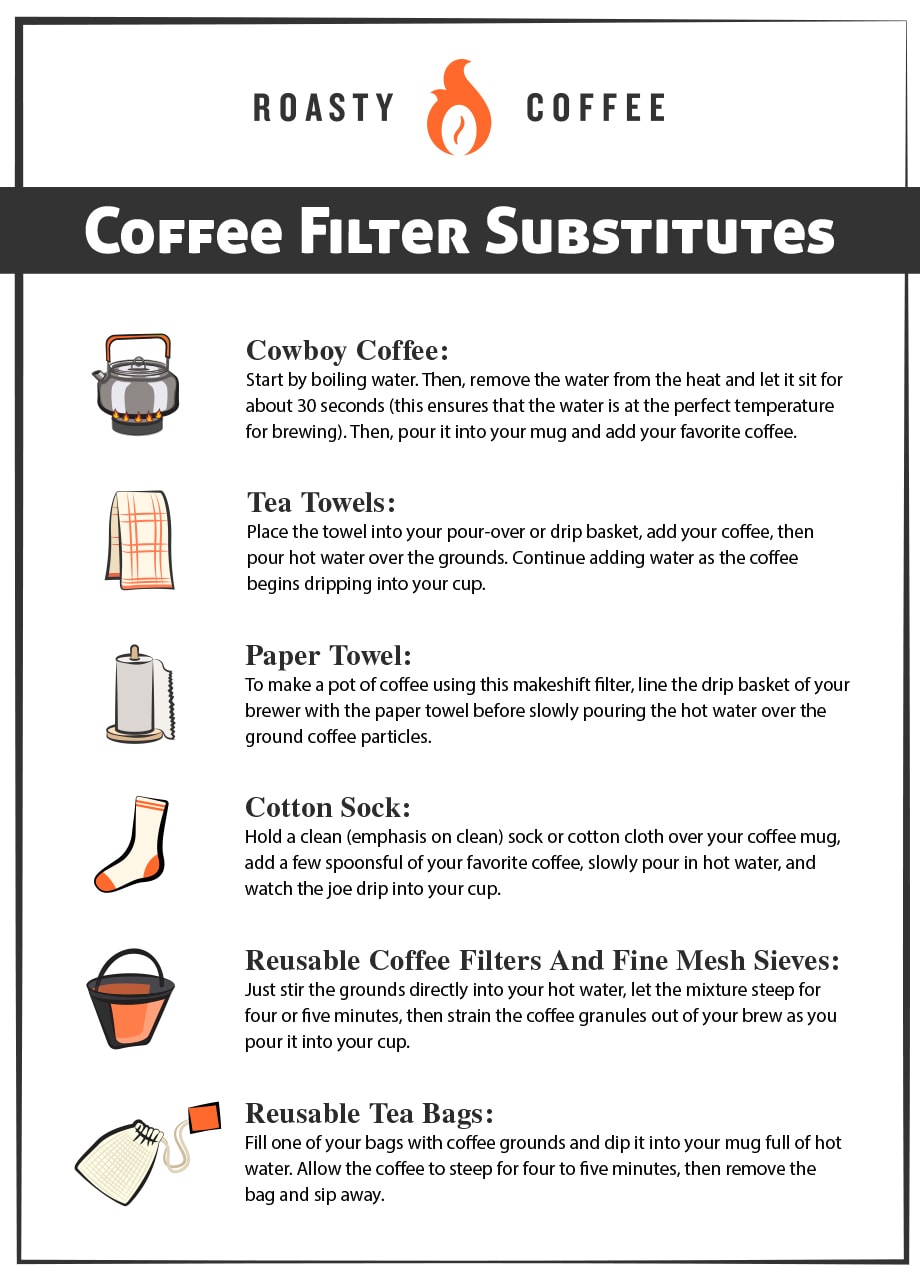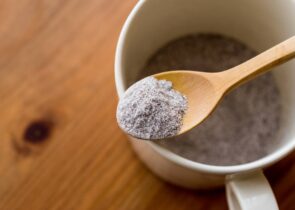Imagine waking up on a lazy Sunday morning, excited to enjoy your favorite single-origin beans when you realize that you’ve run out of paper coffee filters — insert fear-filled shudder here.
More than half of all coffee consumers would rather skip a shower in the morning than skip their coffee. And even though coffee filters are accessible in most stores and you probably have a lot of options where you can get them again, sometimes, leaving the house before your caffeine hit seems like an impossible task.
Or maybe you love your coffee but are concerned about the issues of cost and sustainability when constantly purchasing paper filters for your brewer.
Either way, luckily, excellent alternative coffee filter substitutes can be commonly found in your household. Which ones would we recommend? Read on to find out!
Roasty’s Favorite Substitutes for Coffee Filters

Cowboy Coffee
When you’re out of filters and don’t have a coffee filter replacement readily available, the easiest thing to do is skip the filter altogether and make cowboy coffee.
It’s easy to make your brew this way. Start by boiling water. Then, remove the water from the heat and let it sit for about 30 seconds (this ensures that the water is at the perfect temperature for brewing). Then, pour it into your mug and add your favorite coffee; you’ll need to add about two tablespoons of coffee grounds per every eight ounces of water you use. Stir the grounds into the water well, and let the mixture steep for a couple of minutes.
Once the coffee’s been brewed, and the grounds have settled to the bottom of your container, pour the coffee into your cup, going slow to make sure none of the gritty grounds end up in your mug.
This brewing method is great for someone who can’t go a day without coffee — no filter? No problem! You can use this method to make multiple cups of coffee at a time, and it saves the day when you’re sleeping under the stars and need your caffeine fix. But fair warning: even if you pour slowly and carefully, you’ll probably still end up with grounds in your cup, and the coffee might taste too bitter and strong.
Tea Towels
This fantastic coffee filter substitute works in every kitchen, and it’s easy, too!
The first step of this coffee filter backup plan is to grab a clean dish towel or cloth that you don’t mind staining. Place the towel into your pour-over or drip basket, add your coffee, then pour hot water over the grounds. Continue adding water as the coffee begins dripping into your cup.
This sustainable method can catch even the finest coffee grounds. However, there’s a possibility of your coffee tasting like laundry detergent, especially when you use a cloth that’s been freshly washed.
Paper Towel
Next up is perhaps the most common homemade coffee filter since you probably already have everything you need to pull it off, and it doesn’t require you to change your brewing method very much. To make a pot of coffee using this makeshift filter, line the drip basket of your brewer with the paper towel before slowly pouring the hot water over the ground coffee particles.
As straightforward as this method sounds, it, unfortunately, comes with many negatives. For starters, paper towels often contain traces of nasty chemicals, glue, or bleach, and those aren’t exactly the kind of add-ins you want in your cup. Plus, paper towels are thin and flimsy, so the paper could break, even if you use several layers.
Note: this coffee filter method only works with a pour-over or drip basket, and you might end up with a papery, chemical-tasting cup. But desperate times call for desperate measures, so if you can’t go without your caffeine kick and you don’t have any filters on hand, this is worth giving a try.
Cotton Sock
Before you dismiss this one, hear us out. The coffee sock has a long history of being an excellent substitute for a coffee filter, dating to one of the first traditional ways of brewing in Costa Rica called the Chorreador.
Hold a clean (emphasis on clean) sock or cotton cloth over your coffee mug, add a few spoonsful of your favorite coffee, slowly pour in hot water, and watch the joe drip into your cup. When you’re finished with this non-traditional coffee filter, just wash the sock, and it’s ready to be used again.
This method, best used with medium or coarsely ground coffee, is one of the most sustainable on our list. But if you don’t like the idea of using a clothing item intended for feet to brew your morning cup, check out coffee socks specifically made to filter coffee.
Reusable Coffee Filters And Fine Mesh Sieves
The best things about reusable filters are that you don’t have to worry about spending your hard-earned cash on disposable paper ones, and you can use them over and over again. Such filters exist for drip coffee makers, pour-over brewers, and even the AeroPress.
But if you don’t have one of these for your coffee maker, don’t stress; you can also use the fine metal strainer you probably already have in your kitchen. Just stir the grounds directly into your hot water, let the mixture steep for four or five minutes, then strain the coffee granules out of your brew as you pour it into your cup.
This may seem like a last-ditch effort to get your coffee ready in the morning, but it actually tastes pretty good. Because paper filters are finer than mesh filters, they catch more oils, which results in a cleaner and brighter cup of coffee. Joe made with a reusable filter or mesh sieve tastes similar to that brewed with a French press, so if you don’t mind a more flavorful and robust taste and higher acidity, this makes an excellent backup option.
Reusable Tea Bags
If you’re a coffee enthusiast who’s also a tea drinker, you might have reusable tea bags around for when you brew loose leaf tea. Fill one of your bags with coffee grounds and dip it into your mug full of hot water. Allow the coffee to steep for four to five minutes, then remove the bag and sip away.
While this method is not that common, it works well in producing a tasty cup that doesn’t have even a bit of coffee grounds left at the bottom. However, not everyone has reusable tea bags at home, and buying them just for this purpose can be quite expensive. But if you’ve already got some on hand and you’ve run out of paper filters, why not?
Pro-tip: If you want to try this method but don’t have reusable tea bags handy, use a piece of cheesecloth and string to make your own coffee bags — just make sure to tie your bags tightly, so no gritty grounds escape into your cup.
Instant Coffee
Instant coffee won’t fully satisfy your tastebuds if you’re among the coffee purists who insist on brewing only Colombian beans in your Chemex every day. Still, it’s a good idea to keep a jar of these dehydrated coffee granules in your cupboard for emergency purposes. You know, like when you’ve run out of paper filters and your fancy coffee beans — scary, we know.
Try A Filterless Alternative Brewing Method
One of the best ways to avoid running out of filters and having to improvise to make your coffee ritual work is switching to a method that doesn’t require a filter at all.
Brewers like the French press, percolator, or Moka pot are designed to be used without a filter, plus they’re budget-friendly and can produce a tasty cup of coffee. One thing to consider, though, is that in general, they usually produce a taste that is more robust and full-bodied than a coffee brewed using paper filters, so if you’re not a fan of super-strong coffee, these coffee brewing methods may not be for you.
Frequently Asked Questions
Can you drink ground coffee without filtering it?
Yes, you can! For example, if you’re making cowboy coffee or the very similar Turkish coffee, you won’t filter any of the grounds from your cup.
If you do opt to brew your joe with a filter-free method, though, keep in mind that there will be grit at the bottom of your mug, so you’ll either have to sip very slowly or very carefully transfer the liquid to another cup, so you don’t end up with a mouth full of coarse coffee grounds.
Can you use cupcake liners for coffee filters?
No! Even though cupcake liners look eerily similar to paper coffee filters, they make inadequate coffee filter alternatives. Cupcake liners are designed to keep everything inside of them, including moisture, so your coffee wouldn’t filter through them very well.
Cupcake liners are made of different materials. The paper used to make coffee filters are perforated so your brew can easily be separated from your coffee beans. Cupcake liners are made of solid, perforation-free paper, so nothing’s getting out of those little guys.
Does toilet paper work as a coffee filter?
We understand the struggle of preparing to fire up your trusty drip coffee machine only to discover you’re out of coffee filters. You might be tempted to try anything as a makeshift coffee filter, even toilet paper. And while we admire your innovation and dedication to your morning cup, we strongly advise against making bathroom tissue part of your brewing process.
Some say the paper towel method above works just as well with toilet paper, but we’re here to tell you it doesn’t. Toilet paper tends to break down when it comes in contact with water, so that means your chances of ending up with a cup full of paper sludge — or worse, a clogged machine! — are pretty high if you use the stuff as an alternative to coffee filters.
What are the side effects of unfiltered coffee?
Of course, a stronger tasting cup is a result of unfiltered coffee since none of the beans’ natural oils are filtered out. But studies have shown there are also health-related side effects of drinking unfiltered joe, too.
According to a report in the American Journal of Clinical Nutrition, Dutch researchers have found that consuming high amounts of unfiltered coffee raises the blood levels of homocysteine, a compound that, when increased, raises cholesterol levels and, in turn, the chances of a stroke or heart disease.
However, the study participants consumed up to a liter of java a day, which is far more than the recommended coffee consumption amount anyway. So, as long as filter-free brewing methods aren’t your only means of making coffee and you limit your intake, you should be fine.
Disaster Averted — Drink Away!
All serious coffee lovers know that waking up in the morning to find you’ve run out of filters is a nightmare, but there’s no need to panic; as you can see above, there are many substitutes for coffee filters, and each can produce a pretty good cup.
While some alternatives to coffee filters, like paper towels, have significant limitations and aren’t exactly ideal unless you’re in a pinch, other methods, like using a mesh strainer or coffee sock, for example, can remove coffee grounds fairly efficiently and produce a mighty tasty cup.
The next time you forget to check your supply of filters for your morning caffeine kick, don’t be afraid to experiment with one of our recommendations. Any of them can act as a substitute for coffee filters, or you can use alternative brewing methods like the French press.
Happy Caffeinating!







